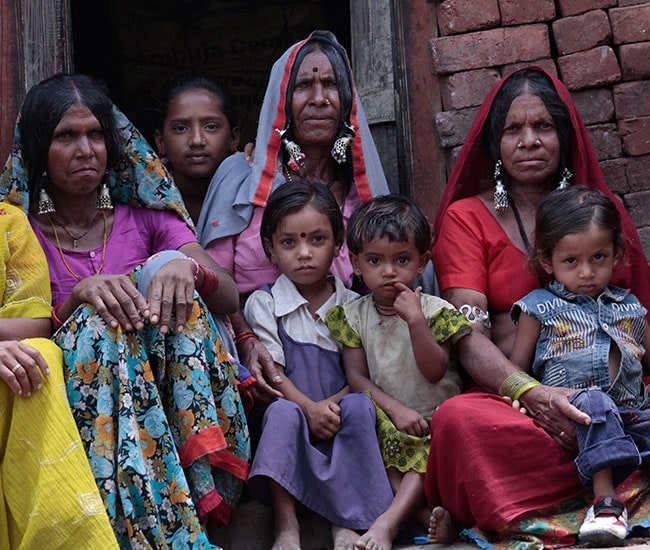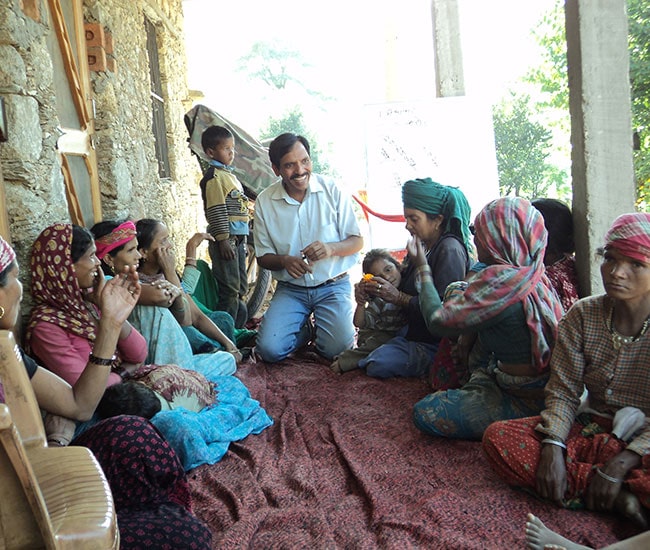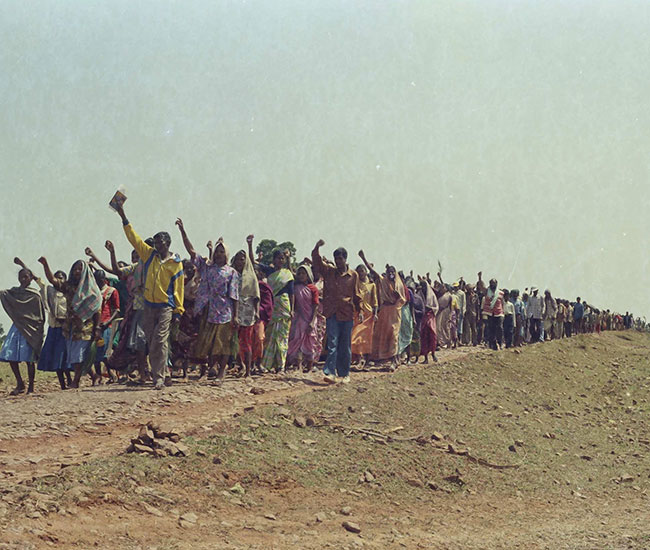
Khetihar Khan Mazdoor Sangathan
Chittorgarh district lies in the south eastern part of Rajasthan and has a population of over 18 lakhs. 85% of the people live in rural areas, agriculture and mining being the main sources of livelihood. Most of the land is owned by the jats, and the dalits and tribal communities, owing to the insignificant size of their land holdings, are forced to work in mines or on the lands of others often as bonded labour. Feudal attitudes and practices continue to have a strong presence in the region.
Khetihar Khan Mazdoor Sangathan
In 1989 Khemraj and his associates visited the stone quarries in Pratapgarh and saw first hand the poor condition of the workers. There were men and women who had been working as bonded labour for more than 20 years. After meetings and discussions, finally one individual, a Dalit by the name of Choga Meghwal, came to them asking for help to be released. A case was filed in Chittorgarh, and won. The victim was freed, awarded compensation of Rs. 500, given 5 bighas of land, a goat unit and police protection. Encouraged by this, others came forward, cases were filed every week and 256 bonded labourers were released. This movement galvanised the people and the Khetihar Khan Mazdoor Sangathan was formed.
The sangathan is now active in the Badesar, Nimbahera, Badi Sadri, Chhoti Sadri, Dungla, Kapasan and Chittorgarh blocks of Chittorgarh district taking up issues of land alienation, caste discrimination, rights of labourers and atrocities against women. Over the years, their efforts have led to 5 crores worth of land being returned to their rightful owners. The work of the sangathan goes on at three levels: by regularly visiting the villages, being in touch with the people and helping solve problems related to water, schools, NREGA, PDS etc; by doing welfare programmes in collaboration with Prayas; and by taking up issues of exploitation and discrimination and fighting till justice is delivered. This issue based activism has been the most significant part of their contribution and has led to substantial changes on the ground—in the attitudes of the authorities as well as in the self confidence of the dalits and tribal communities.
The methods used by the sangathan are innovative and demonstrative, and by no means docile, making a forceful point every time. It is known that for centuries, dalits have been at the receiving end of several discriminatory practices and rules, including one that said that a dalit can’t sit on a Khat in front of a person from an upper caste. The sangathan sought to break this by organising what became famous as the Khat Andolan in which 2000 dalits, Bhils and other oppressed communities from villages all around gathered for a meeting at Achalpura village and sat on Khats for the whole day right in front of the upper caste houses.
Empowering the Bhil community
The focus area of the sanghathan has been Bhil community, the most backward and oppressed of the tribal communities. Though Bhils are the original inhabitants of the region, their land was taken over by the upper castes and they were subsequently enslaved. Now 80% of their land is mortgaged, literacy rates are abysmally low and the Bhil men and women suffer daily indignities.
In 2004-2005, the sangathan mobilised the Bhils and more than 400 members of the community participated in a Long March from Chittorgarh to Jaipur with demands that all Bhils should be in BPL and that an Act should be formulated on land alienation. Sustained by contributions of Rs. 20 per family made by the Bhils and other communities who came out in support, the people marched in December, distributing pamphlets, holding workshops en route, discussing why the Bhils got enslaved, and how they can come out of it. Finally no action was taken at the government level in their favour, but it went a long way in building the political consciousness of the Bhils who participated. (Bhiladi story)
School Initiatives
The sangathan has been running a primary school for tribal and destitute girls with the support of Asha Foundation. 58 girls now live and study in the school in Amarpura. This initiative seeks to address the 7% literacy rate amongst females in the Bhil community as well as their health and nutrition needs.
Since 2010 the sangathan has been working intensively among the migrant workers in the 66 brick kilns in Bhilwara district. They set up an office there, did a survey on the children working there and presented it to the government. This has led to the opening of 69 NFE (Non Formal Education) schools whose functioning the sangathan is carefully monitoring.
The core group of the sangathan has 9 members, most of them from the Bhil and dalit communities. Each of them has taken the initiative in championing many a case of illegal land appropriation, bonded labour and rape. Narayani is a Bhil woman who has emerged as one of the main workers of the sangathan, fighting for the rights of and leading the way for the empowerment of other women of her community.
The network of the sangathan is very strong, and they can mobilise large numbers of people when major issues come up. In some villages it has managed to create local groups who can fight their own battles rather than be dependent on them. In Hattipura, for example, there is a youth group of 20-22 members called Eklavya that takes up local issues. In other places, the process of empowerment is ongoing, the final aim being that people have the knowledge, confidence and drive to unite and claim their entitlements and rights.
Stories
Khat Andolan
In many villages in this region, dalits are not allowed to talk loudly or sit outside their houses on a Khat; they can’t enter temples and the women can’t wear slippers while walking in the upper caste areas—these restrictions in place so as not to disturb the hegemony of the privileged castes. In 2006, there was an incident in Achalpura village in which a Rajput beat up the guests of a Meghwal family who ‘dared’ to sit on Khats in their presence. There was another instance around the same time in which a young man was beaten because he sat on a chair in a Jat’s house. When these were brought to the notice of the sangathan, meetings and discussions were held with dalits, Bhils and other tribals from many villages and it was decided that on 15 December, 2006, everyone would gather in Achalpura and sit on Khats all day in the same place where the Meghwals had been beaten up. On the appointed day, 350 khats were arranged for and more than 2000 people participated, their slogan being Azadi hai Saatth par, Aao baithein khat par. This protest sent the message loud and clear to all the upper caste people. There was some retaliation from them in the form of social boycott, withdrawal of jobs (most of the dalits were working as labourers on the lands of the Rajputs and Jats) and demand for immediate repayment of loans. But, these subsided in time. More importantly, the dalits themselves began to believe that they don’t have to bow down quietly to abusive behaviour, they can stand up and fight.
Bhiladi
16 km from Bhadesar, in a village called Bhiladi the government was making a road in 2007. While the road was made in such a way that it went around the lands of the jats, when it came to the land of the Bhils, it was said that the road would have to cut across the land. The houses of the Bhil families were destroyed as was the crop that was ready for harvest. The root of the problem lay in the fact that the upper caste villagers were angry that the Bhils who had been bonded labour on their fields till recently had got a very good piece of land after some litigation and hence were freed. There was a violent confrontation between the sangathan people and the villagers. Then a big meeting was planned on the site of the destruction. 10000 people from all over the district attended with tractors and dhols, and the campaign led to the Bhil families getting compensation and the route of the road being reworked.
Narayani
Narayani is a Bhil woman from Umedpura village who was catapulted into activism in the mid 1990s when she impressed Khemraj with her ability to speak confidently on a microphone in front of a huge crowd. In a community where women never used to speak in public, this was a rarity. Though she was illiterate she gained a good understanding of the law and the legal system when she fought and won a case against her husband who had remarried. She has worked for many years with Prayas and the sangathan in the campaign for water, making and running SHGs, and helping release land usurped from Bhils. She has also been instrumental in getting convictions in rape cases of Bhil women by upper caste men. She is now in charge of 10 villages and is a force to be reckoned with among the people and the local authorities.



